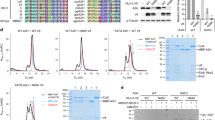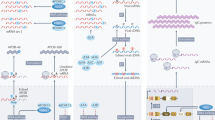Abstract
APOBEC-2 (APO2) belongs to the family of apolipoprotein B messenger RNA-editing enzyme catalytic (APOBEC) polypeptides, which deaminates mRNA and single-stranded DNA1,2. Different APOBEC members use the same deamination activity to achieve diverse human biological functions. Deamination by an APOBEC protein called activation-induced cytidine deaminase (AID) is critical for generating high-affinity antibodies3, and deamination by APOBEC-3 proteins can inhibit retrotransposons and the replication of retroviruses such as human immunodeficiency virus and hepatitis B virus4,5,6,7. Here we report the crystal structure of APO2. APO2 forms a rod-shaped tetramer that differs markedly from the square-shaped tetramer of the free nucleotide cytidine deaminase, with which APOBEC proteins share considerable sequence homology. In APO2, two long α-helices of a monomer structure prevent the formation of a square-shaped tetramer and facilitate formation of the rod-shaped tetramer via head-to-head interactions of two APO2 dimers. Extensive sequence homology among APOBEC family members allows us to test APO2 structure-based predictions using AID. We show that AID deamination activity is impaired by mutations predicted to interfere with oligomerization and substrate access. The structure suggests how mutations in patients with hyper-IgM-2 syndrome inactivate AID, resulting in defective antibody maturation.
This is a preview of subscription content, access via your institution
Access options
Subscribe to this journal
Receive 51 print issues and online access
$199.00 per year
only $3.90 per issue
Buy this article
- Purchase on Springer Link
- Instant access to full article PDF
Prices may be subject to local taxes which are calculated during checkout




Similar content being viewed by others
References
Pham, P., Bransteitter, R. & Goodman, M. F. Reward versus risk: DNA cytidine deaminases triggering immunity and disease. Biochemistry 44, 2703–2715 (2005)
Conticello, S. G., Thomas, C. J. F., Petersen-Mahrt, S. K. & Neuberger, M. S. Evolution of the AID/APOBEC family of polynucleotide (deoxy)cytidine deaminases. Mol. Biol. Evol. 22, 367–377 (2004)
Bransteitter, R., Sneeden, J. L., Allen, S., Pham, P. & Goodman, O. M. F. First AID (activation-induced cytidine deaminase) is needed to produce high affinity isotype-switched antibodies. J. Biol. Chem. 281, 16833–16836 (2006)
Chiu, Y. L. & Greene, W. C. Multifaceted antiviral actions of APOBEC3 cytidine deaminases. Trends Immunol. 27, 291–297 (2006)
Cullen, B. R. Role and mechanism of action of the APOBEC3 family of antiretroviral resistance factors. J. Virol. 80, 1067–1076 (2006)
Franca, R., Spadari, S. & Maga, G. APOBEC deaminases as cellular antiviral factors: a novel natural host defense mechanism. Med. Sci. Monit. 12, RA92–RA98 (2006)
Bonvin, M. et al. Interferon-inducible expression of APOBEC3 editing enzymes in human hepatocytes and inhibition of hepatitis B virus replication. Hepatology 43, 1364–1374 (2006)
Johansson, E., Mejlhede, N., Neuhard, J. & Larsen, S. Crystal structure of the tetrameric cytidine deaminase from Bacillus subtilis at 2.0 Å resolution. Biochemistry 41, 2563–2570 (2002)
Xie, K. et al. The structure of a yeast RNA-editing deaminase provides insight into the fold and function of activation-induced deaminase and APOBEC-1. Proc. Natl Acad. Sci. USA 101, 8114–8119 (2004)
Teh, A. et al. The 1.48 Å resolution crystal structure of the homotetrameric cytidine deaminase from mouse. Biochemistry 45, 7825–7833 (2006)
Chung, S. J., Fromme, J. C. & Verdine, G. L. Structure of human cytidine deaminase bound to a potent inhibitor. J. Med. Chem. 48, 658–660 (2005)
Betts, L., Xiang, S., Short, S. A., Wolfenden, R. & Carter, C. W. Cytidine deaminase. The 2.3 Å crystal structure of an enzyme: transition-state analog complex. Curr. Biol. 235, 635–656 (1994)
Smith, A. A., Carlow, D. C., Wolfenden, R. & Short, S. A. Mutations affecting transition-state stabilization by residues coordinating zinc at the active site of cytidine deaminase. Biochemistry 33, 6468–6474 (1994)
Durandy, A., Peron, S. & Fischer, A. Hyper-IgM syndromes. Curr. Opin. Rheumatol. 18, 369–376 (2006)
Minegishi, Y. et al. Mutations in activation-induced cytidine deaminase in patients with hyper IgM syndrome. Clin. Immunol. 97, 203–210 (2000)
Anant, S. et al. ARCD-1, an apobec-1-related cytidine deaminase, exerts a dominant negative effect on C to U RNA editing. Am. J. Cell Physiol. 281, C1904–C1916 (2001)
Jarmuz, A. et al. An anthropoid-specific locus of orphan C to U RNA-editing enzymes on chromosome 22. Genomics 79, 285–296 (2002)
Shindo, K. et al. The enzymatic activity of CEM15/Apobec-3G is essential for the regulation of the infectivity of HIV-1 virion but not a sole determinant of its antiviral activity. J. Biol. Chem. 278, 44412–44416 (2003)
Wiegand, H. L., Doehle, B. P., Bogerd, H. P. & Cullen, B. R. A second human antiretroviral factor, APOBEC3F, is suppressed by the HIV-1 and HIV-2 Vif proteins. EMBO J. 23, 2451–2458 (2004)
Opi, S. et al. Monomeric APOBEC3G is catalytically active and has antiviral activity. J. Virol. 80, 4673–4682 (2006)
Navarro, F. et al. Complementary function of the two catalytic domains of APOBEC3G. Virology 333, 374–386 (2005)
Wang, J. et al. Identification of a specific domain required for dimerization of activation-induced cytidine deaminase. J. Biol. Chem. (in the press).
Teng, B. et al. Mutational analysis of apolipoprotein B mRNA editing enzyme (APOBEC1): structure-function relationships of RNA editing and dimerization. J. Lipid Res. 40, 623–635 (1999)
Otwinowski, Z. & Minor, W. Processing of X-ray diffraction data collected in oscillation mode. Methods Enzymol. 276, 307–326 (1997)
Terwilliger, T. C. & Berendzen, J. Automated MAD and MIR structure solution. Acta Crystallogr. 55, 849–861 (1999)
Schneider, T. R. & Sheldrick, G. M. Substructure solution with SHELXD. Acta Crystallogr. 58, 1772–1779 (2002)
Terwilliger, T. C. Maximum-likelihood density modification. Acta Crystallogr. 56, 965–972 (2000)
Bransteitter, R., Pham, P., Scharff, M. D. & Goodman, M. F. Activation-induced cytidine deaminase deaminates deoxycytidine on single-stranded DNA but requires the action of RNase. Proc. Natl Acad. Sci. USA 100, 4102–4107 (2003)
Acknowledgements
We thank L. Chen for comments on the manuscript. We also thank G. Wang from Chen lab and the staff at ALS LBL8.2.1, BL8.2.2 and APS 19id in the Argonne National Laboratory for assistance in data collection. This work was supported in part by National Institutes of Health grants to M.F.G. and X.S.C. and an NIH-NIA Predoctoral Traineeship to R.B. The structure of APO2 has been uploaded to the Protein Data Bank under accession number 2NYT and to the Research Collaboratory for Structural Bioinformatics (RCSB) under accession number RCSB040471.
Author information
Authors and Affiliations
Corresponding author
Ethics declarations
Competing interests
The structure of APO2 has been uploaded to the Protein Data Bank under accession number 2NYT and to the Research Collaboratory for Structural Bioinformatics (RCSB) under accession number RCSB040471. Reprints and permissions information is available at www.nature.com/reprints. The authors declare no competing financial interests.
Supplementary information
Supplementary Information
This file contains Supplementary Table 1 which is consisting of data collection, phasing and refinement statistics (MIR) for the Apo2 structure. Methods provide information about the Apo2 protein purification and crystallization, Apo2 structure determination and refinement, construction of AID mutants and AID deamination reaction. (PDF 138 kb)
Rights and permissions
About this article
Cite this article
Prochnow, C., Bransteitter, R., Klein, M. et al. The APOBEC-2 crystal structure and functional implications for the deaminase AID. Nature 445, 447–451 (2007). https://doi.org/10.1038/nature05492
Received:
Accepted:
Published:
Issue Date:
DOI: https://doi.org/10.1038/nature05492
This article is cited by
-
Functions and consequences of AID/APOBEC-mediated DNA and RNA deamination
Nature Reviews Genetics (2022)
-
A Monist Proposal: Against Integrative Pluralism About Protein Structure
Erkenntnis (2022)
-
Understanding the Structure, Multimerization, Subcellular Localization and mC Selectivity of a Genomic Mutator and Anti-HIV Factor APOBEC3H
Scientific Reports (2018)
-
A licensing step links AID to transcription elongation for mutagenesis in B cells
Nature Communications (2018)
-
Impacts of Early Life Stress on the Methylome and Transcriptome of Atlantic Salmon
Scientific Reports (2017)
Comments
By submitting a comment you agree to abide by our Terms and Community Guidelines. If you find something abusive or that does not comply with our terms or guidelines please flag it as inappropriate.



